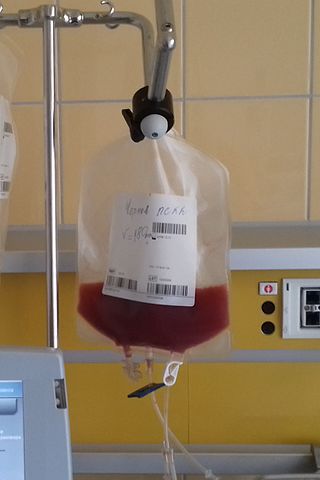Related Research Articles
Allotransplant is the transplantation of cells, tissues, or organs to a recipient from a genetically non-identical donor of the same species. The transplant is called an allograft, allogeneic transplant, or homograft. Most human tissue and organ transplants are allografts.

Samarium (153Sm) lexidronam is a chelated complex of a radioisotope of the element samarium with EDTMP. It is used to treat pain when cancer has spread to the bone.

Acute myeloblastic leukemia without maturation is a quickly progressing disease in which too many immature white blood cells are found in the blood and bone marrow.

Adenosquamous carcinoma is a type of cancer that contains two types of cells: squamous cells and gland-like cells. It has been associated with more aggressive characteristics when compared to adenocarcinoma in certain cancers. It is responsible for 1% to 4% of exocrine forms of pancreas cancer.

Atiprimod is a substance being studied in the treatment of certain multiple myelomas and other advanced cancers. It may block the growth of tumors and the growth of blood vessels from surrounding tissue to the tumor. This drug is also being researched as a potential treatment for various autoimmune diseases. It was first developed by GlaxoSmithKline as a potential treatment for rheumatoid arthritis. The substance is also known as azaspirane, although this more properly refers to the class of chemicals to which atiprimod belongs.
Blastic phase chronic myelogenous leukemia is a phase of chronic myelogenous leukemia in which more than 30% of the cells in the blood or bone marrow are blast cells. When tiredness, fever, and an enlarged spleen occur during the blastic phase, it is called blast crisis.
Autologous stem-cell transplantation is autologous transplantation of stem cells—that is, transplantation in which stem cells are removed from a person, stored, and later given back to that same person.
Clear cell sarcoma of the kidney (CCSK) is an extremely rare type of kidney cancer comprising 3% of all pediatric renal tumours. Clear cell sarcoma of the kidney can spread from the kidney to other organs, most commonly the bone, but also including the lungs, brain, and soft tissues of the body.
Transsphenoidal surgery is a type of surgery in which an endoscope or surgical instruments are inserted into part of the brain by going through the nose and the sphenoid bone into the sphenoidal sinus cavity. Transsphenoidal surgery is used to remove tumors of the pituitary gland..
Chronic phase chronic myelogenous leukemia is a phase of chronic myelogenous leukemia in which 5% or fewer of the cells in the blood and bone marrow are blast cells. This phase may last from several months to several years, and there may be no symptoms of leukemia.
Dose-dense chemotherapy is a chemotherapy treatment plan in which drugs are given with less time between treatments than in a standard chemotherapy treatment plan.
Spindle cell carcinoma is a type of cancer that begins in the skin or in tissues that line or cover internal organs and that contains long spindle-shaped cells. It is also called sarcomatoid carcinoma.
Ribonucleotide reductase inhibitors are a family of anti-cancer drugs that interfere with the growth of tumor cells by blocking the formation of deoxyribonucleotides.

Peripheral blood stem cell transplantation (PBSCT), also called "Peripheral stem cell support", is a method of replacing blood-forming stem cells. Stem cells can be destroyed through cancer treatments such as chemotherapy or radiation, as well as any blood-related diseases, such as leukemia, lymphoma, neuroblastoma and multiple myeloma. PBSCT is now a much more common procedure than its bone marrow harvest equivalent due to the ease and less invasive nature of the procedure. Studies suggest that PBSCT has a better outcome in terms of the number of hematopoietic stem cell yield.
Erythroid dysplasia is a condition in which immature red blood cells in the bone marrow are abnormal in size and/or number. Erythroid dysplasia may be caused by vitamin deficiency or chemotherapy, or it may be a sign of refractory anemia, which is a myelodysplastic syndrome. Also called erythrodysplasia.
T-lymphoblastic leukemia/lymphoma, previously labeled precursor T-lymphoblastic leukemia/lymphoma is a form of lymphoid leukemia and lymphoma in which too many T-cell lymphoblasts are found in the blood, bone marrow, and tissues, particularly mediastinal lymph nodes. Labeling as leukemia or lymphoma depends on which feature is more pronounced in a given situation, but has no biological or treatment implication.

Precursor B-cell lymphoblastic leukemia is a form of lymphoid leukemia in which too many B-cell lymphoblasts are found in the blood and bone marrow. It is the most common type of acute lymphoblastic leukemia (ALL). It is sometimes additionally classified as a lymphoma, as designated leukemia/lymphoma. ALL is the most prevalent childhood malignancy, with precursor B-cell ALL (B-ALL) accounting for approximately 75–80% of newly diagnosed pediatric ALL cases.
Segmental resection is a surgical procedure to remove part of an organ or gland, as a sub-type of a resection, which might involve removing the whole body part. It may also be used to remove a tumor and normal tissue around it. In lung cancer surgery, segmental resection refers to removing a section of a lobe of the lung. The resection margin is the edge of the removed tissue; it is important that this shows free of cancerous cells on examination by a pathologist.
Microwave thermotherapy is a type of treatment in which body tissue is heated by microwave irradiation to damage and kill cancer cells or to make cancer cells more sensitive to the effects of radiation and certain anticancer drugs.
Stromagen is a product that is made of stem cells taken from a patient's bone marrow and grown in the laboratory. After a patient's bone marrow is destroyed by treatment with whole body irradiation or chemotherapy, these cells are injected back into the patient to help rebuild bone marrow. Stromagen has been studied in the prevention of graft-versus-host disease during stem cell transplant in patients receiving treatment for cancer. Stromagen is used in cellular therapy. Also called autologous expanded mesenchymal stem cells OTI-010. Peripheral stem cell transplantation may allow doctors to give higher doses of chemotherapy and kill more tumor cells. It is not yet known whether Stromagen improves the success of stem cell transplantation in women with breast cancer.
References
- Bone-seeking radioisotope entry in the public domain NCI Dictionary of Cancer Terms
![]() This article incorporates public domain material from Dictionary of Cancer Terms. U.S. National Cancer Institute.
This article incorporates public domain material from Dictionary of Cancer Terms. U.S. National Cancer Institute.